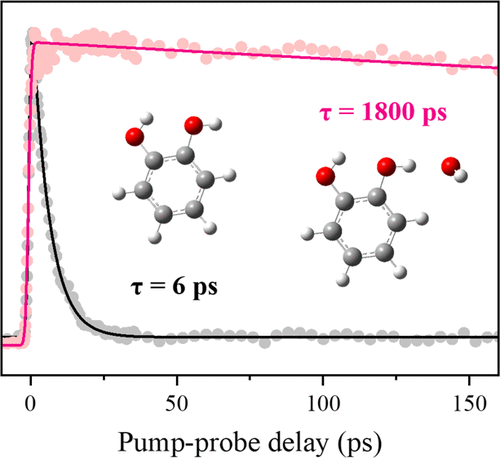当前位置:
X-MOL 学术
›
J. Phys. Chem. A
›
论文详情
Our official English website, www.x-mol.net, welcomes your
feedback! (Note: you will need to create a separate account there.)
S1-State Decay Dynamics of Benzenediols (Catechol, Resorcinol, and Hydroquinone) and Their 1:1 Water Clusters
The Journal of Physical Chemistry A ( IF 2.7 ) Pub Date : 2021-08-25 , DOI: 10.1021/acs.jpca.1c05448 Kuk Ki Kim 1 , Junggil Kim 1 , Kyung Chul Woo 1 , Sang Kyu Kim 1
The Journal of Physical Chemistry A ( IF 2.7 ) Pub Date : 2021-08-25 , DOI: 10.1021/acs.jpca.1c05448 Kuk Ki Kim 1 , Junggil Kim 1 , Kyung Chul Woo 1 , Sang Kyu Kim 1
Affiliation

|
The S1-state decaying rates of the three different benzenediols, catechol, resorcinol, and hydroquinone, and their 1:1 water clusters have been state-specifically measured using the picosecond time-resolved parent ion transients obtained by the pump (excitation) and probe (ionization) scheme. The S1 lifetime of catechol is found to be short, giving τ ∼ 5.9 ps at the zero-point level. This is ascribed to the H-atom detachment from the free OH moiety of the molecule. Consistent with a previous report (J. Phys. Chem. Lett.2013, 4, 3819–3823), the S1 lifetime gets lengthened with low-frequency vibrational mode excitations, giving τ ∼ 9.0 ps for the 116 cm–1 band. The S1 lifetimes at the additional vibronic modes of catechol are newly measured, showing the nonnegligible mode-dependent fluctuations of the tunneling rate. When catechol is complexed with water, the S1 lifetime is enormously increased to τ ∼ 1.80 ns at the zero-point level while it shows an unusual dip at the intermolecular stretching mode excitation (τ ∼ 1.03 ns at 146 cm–1). Otherwise, it is shortened monotonically with increasing the internal energy, giving τ ∼ 0.67 ns for the 856 cm–1 band. Two different asymmetric or symmetric conformers of resorcinol give the respective S1 lifetimes of 4.5 or 6.3 ns at their zero-point levels according to the estimation from our transients taken within the temporal window of 0–2.7 ns. When resorcinol is 1:1 complexed with H2O, the S1 decaying rate is slightly accelerated for both conformers. The S1 lifetimes of trans and cis forms of hydroquinone are measured to be more or less same, giving τ ∼ 2.8 ns at the zero-point level. When H2O is complexed with hydroquinone, the S1 decaying process is facilitated for both conformers, slightly more efficiently for the cis conformer.
中文翻译:

苯二酚(儿茶酚、间苯二酚和对苯二酚)及其 1:1 水团簇的 S1 态衰变动力学
在S 1的三个不同的苯二酚,邻苯二酚,间苯二酚和氢醌,以及它们的1 -state衰减率:1的水簇一直状态特异性使用由泵(激发)中获得的皮秒时间分辨母离子瞬变测定和探针(电离)方案。发现儿茶酚的 S 1寿命很短,在零点水平上给出 τ ∼ 5.9 ps。这归因于 H 原子从分子的游离 OH 部分脱离。与之前的报告 ( J. Phys. Chem. Lett. 2013 , 4 , 3819–3823) 一致,S 1寿命随着低频振动模式激发而延长,116 cm –1波段的τ ∼ 9.0 ps 。S新测量了儿茶酚额外振动模式下的1寿命,显示了隧道速率的不可忽略的模式相关波动。当儿茶酚与水络合时,S 1寿命在零点水平显着增加至 τ ∼ 1.80 ns,而在分子间拉伸模式激发(τ ∼ 1.03 ns 在 146 cm –1 处)显示出异常下降。否则,它会随着内能的增加而单调缩短,从而为 856 cm –1波段提供 τ ∼ 0.67 ns 。间苯二酚的两种不同的不对称或对称构象异构体给出各自的 S 1根据我们在 0-2.7 ns 时间窗口内进行的瞬态估计,在零点水平上的寿命为 4.5 或 6.3 ns。当间苯二酚以 1:1 与 H 2 O复合时,两种构象异构体的 S 1衰减速率都会略微加快。在S 1的寿命的反式与顺式的氢醌的形式测得为或多或少相同,在零点电平给τ〜2.8纳秒。当 H 2 O 与对苯二酚复合时,两种构象异构体的 S 1衰变过程都得到促进,顺式构象异构体的效率稍高一些。
更新日期:2021-09-09
中文翻译:

苯二酚(儿茶酚、间苯二酚和对苯二酚)及其 1:1 水团簇的 S1 态衰变动力学
在S 1的三个不同的苯二酚,邻苯二酚,间苯二酚和氢醌,以及它们的1 -state衰减率:1的水簇一直状态特异性使用由泵(激发)中获得的皮秒时间分辨母离子瞬变测定和探针(电离)方案。发现儿茶酚的 S 1寿命很短,在零点水平上给出 τ ∼ 5.9 ps。这归因于 H 原子从分子的游离 OH 部分脱离。与之前的报告 ( J. Phys. Chem. Lett. 2013 , 4 , 3819–3823) 一致,S 1寿命随着低频振动模式激发而延长,116 cm –1波段的τ ∼ 9.0 ps 。S新测量了儿茶酚额外振动模式下的1寿命,显示了隧道速率的不可忽略的模式相关波动。当儿茶酚与水络合时,S 1寿命在零点水平显着增加至 τ ∼ 1.80 ns,而在分子间拉伸模式激发(τ ∼ 1.03 ns 在 146 cm –1 处)显示出异常下降。否则,它会随着内能的增加而单调缩短,从而为 856 cm –1波段提供 τ ∼ 0.67 ns 。间苯二酚的两种不同的不对称或对称构象异构体给出各自的 S 1根据我们在 0-2.7 ns 时间窗口内进行的瞬态估计,在零点水平上的寿命为 4.5 或 6.3 ns。当间苯二酚以 1:1 与 H 2 O复合时,两种构象异构体的 S 1衰减速率都会略微加快。在S 1的寿命的反式与顺式的氢醌的形式测得为或多或少相同,在零点电平给τ〜2.8纳秒。当 H 2 O 与对苯二酚复合时,两种构象异构体的 S 1衰变过程都得到促进,顺式构象异构体的效率稍高一些。









































 京公网安备 11010802027423号
京公网安备 11010802027423号